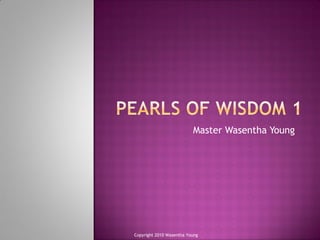
Master Young - Pearls Of Wisdom 1
- 1. Master Wasentha Young Copyright 2010 Wasentha Young
- 2. Intro Translating Information Reverse Breathing Breathing “Happens” Proper Mind/Body/Energy Mechanics Direct Instruction Pearls of Wisdom Copyright 2010 Wasentha Young
- 3. Copyright 2010 Wasentha Young In the over 35 years of teaching, “reverse breathing” while doing the t’ai chi ch’uan form has raised to the surface either through my readings on the art form or questions from students.
- 4. Translating information about a t’ai chi ch’uan requires: Insight into language – verbal, mental, and body; Discussions on the history and philosophy of both the initial and translated - cultures; Deep study of how the people (of the translated language) use their language. Copyright 2010 Wasentha Young
- 5. Passing information from one person to another is hard enough - imagine the challenge of passing on information over millenniums Copyright 2010 Wasentha Young
- 6. Instinctually, I have come to realize that what might have been a statement about simple body/energy mechanics, over the millennium and translations, may have become so much more. We find ourselves forcing– rather than feeling concepts. Take “reverse breathing” for instance. Copyright 2010 Wasentha Young
- 7. I have read and spoken with people on this topic and have found that many use force by “pulling” in the stomach when inhaling, and “push” out the stomach when exhaling. One of the primary (Taoist) principles is not to force; therefore, I can hardly believe that this is what is meant by reverse breathing. Copyright 2010 Wasentha Young
- 8. Having attended many workshops – Grandmaster Chen’s seminars – although he never directly spoke of it - brought about the clearest understanding of this technique. The process of reverse breathing “happens” when using the proper body mechanics. It is not a forced process, but a gentle response the body has when the mind, breath, feet and legs are engaged properly. Copyright 2010 Wasentha Young
- 9. Grandmaster Chen’s explanation on specific foot and inner leg activity while doing the form, actually causes a slight contraction of the abdominal wall when inhaling. As you move into a posture, he says, “The body stays down, the energy goes up.” The points in the release of the body, or the “bird preparing for flight” in some the transitional movement causes a passive expansion of the body while exhaling. Copyright 2010 Wasentha Young
- 10. I refrain from being more specific and mentioning at what points these body mechanics happen, because in reading, translating this into actions can be misinterpreted. “It is best for students to receive direct instructions, because it is in the safety of guidance that the discussions and questions can be addressed.” Master Young Copyright 2010 Wasentha Young
- 11. In your continued exploration of t’ai chi ch’uan – relax and keep an open mind. Remember that the principles of the form are based in the cultural philosophies; and look for the path of least resistance. Some principles are just statements and not “things” you need to make happen. Master Wasentha Young Copyright 2010 Wasentha Young